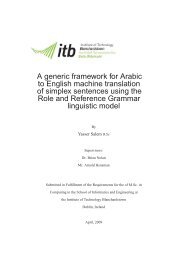On the occurrence and consequences of inaccurate ... - Acsu Buffalo
On the occurrence and consequences of inaccurate ... - Acsu Buffalo
On the occurrence and consequences of inaccurate ... - Acsu Buffalo
You also want an ePaper? Increase the reach of your titles
YUMPU automatically turns print PDFs into web optimized ePapers that Google loves.
transactions in <strong>the</strong>ir sample are correctly classi"ed. While <strong>the</strong> results <strong>of</strong> <strong>the</strong>ir<br />
study are quite informative, <strong>the</strong> focus <strong>of</strong> <strong>the</strong>ir paper di!ers somewhat from mine.<br />
First, <strong>the</strong>y do not provide a detailed breakdown <strong>of</strong> <strong>the</strong> types <strong>of</strong> transactions that<br />
are misclassi"ed. Second, although <strong>the</strong>y also use <strong>the</strong> TORQ database, <strong>the</strong>y focus<br />
on a smaller subset <strong>of</strong> <strong>the</strong> data. I present evidence in Section 4 that <strong>the</strong> trades<br />
eliminated by Lee <strong>and</strong> Radhakrishna tend to be misclassi"ed more frequently.<br />
Finally, Lee <strong>and</strong> Radhakrishna do not investigate <strong>the</strong> <strong>consequences</strong> <strong>of</strong> trade<br />
misclassi"cation.<br />
The accuracy <strong>of</strong> trade classi"cation algorithms has also been examined in<br />
o<strong>the</strong>r markets. For example, Aitken <strong>and</strong> Frino (1996) provided a detailed<br />
analysis <strong>of</strong> <strong>the</strong> performance <strong>of</strong> <strong>the</strong> tick method on Australian stock market data<br />
<strong>and</strong> found that it correctly classi"ed 75% <strong>of</strong> <strong>the</strong> transactions in <strong>the</strong>ir sample.<br />
They also found that it was less accurate for small transactions <strong>and</strong> sellerinitiated<br />
trades. In addition, Ellis et al. (2000) studied <strong>the</strong> accuracy <strong>of</strong> <strong>the</strong> quote,<br />
tick, <strong>and</strong> Lee <strong>and</strong> Ready methods on Nasdaq data. Overall, our results are<br />
strikingly similar. First, <strong>the</strong>y documented accuracy rates <strong>of</strong> 78% for <strong>the</strong> quote<br />
method (when unclassi"ed midpoint trades are labeled as misclassi"ed), 80% for<br />
<strong>the</strong> tick method, <strong>and</strong> 83% for <strong>the</strong> Lee <strong>and</strong> Ready method. Second, <strong>the</strong>y, too,<br />
found that trades that occur inside <strong>the</strong> spread or when trading is frequent are<br />
more likely to be misclassi"ed.<br />
The remainder <strong>of</strong> <strong>the</strong> paper is organized as follows. Section 1 provides<br />
a formal de"nition <strong>of</strong> <strong>the</strong> term &initiator' as it is used here. Section 2 presents <strong>the</strong><br />
Lee <strong>and</strong> Ready trade classi"cation algorithms. The data <strong>and</strong> methodology are<br />
discussed in Section 3. Section 4 contains an analysis <strong>of</strong> <strong>the</strong> results <strong>and</strong> two<br />
sample applications illustrating <strong>the</strong> e!ects <strong>of</strong> misclassi"cation. Section 5 concludes.<br />
1. &Initiator' de5ned<br />
E.R. Odders-White / Journal <strong>of</strong> Financial Markets 3 (2000) 259}286 261<br />
The goal <strong>of</strong> trade classi"cation is to correctly determine <strong>the</strong> initiator <strong>of</strong> <strong>the</strong><br />
transaction. Although <strong>the</strong> concept <strong>of</strong> a trade initiator is used throughout <strong>the</strong><br />
"nance literature, a formal de"nition <strong>of</strong> <strong>the</strong> term is rarely stated. No examination<br />
<strong>of</strong> <strong>the</strong> accuracy <strong>of</strong> trade classi"cation algorithms can be conducted, however,<br />
without an explicit de"nition <strong>of</strong> <strong>the</strong> term &initiator'.<br />
<strong>On</strong>e way to describe initiators is as traders who dem<strong>and</strong> immediate execution<br />
(hereafter, <strong>the</strong> immediacy de"nition). A natural consequence <strong>of</strong> this de"nition is<br />
that traders placing market orders (or limit orders at <strong>the</strong> opposite quote) are<br />
labeled <strong>the</strong> initiators, <strong>and</strong> traders placing limit orders are viewed as non-initiators<br />
or passive suppliers <strong>of</strong> liquidity. A variant <strong>of</strong> this de"nition is used by Lee <strong>and</strong><br />
Radhakrishna (1996) in <strong>the</strong>ir evaluation <strong>of</strong> <strong>the</strong> Lee <strong>and</strong> Ready algorithm.<br />
Problems with this de"nition arise, however, when market orders cross, when<br />
limit orders are matched with o<strong>the</strong>r limit orders, <strong>and</strong> when market orders are
















